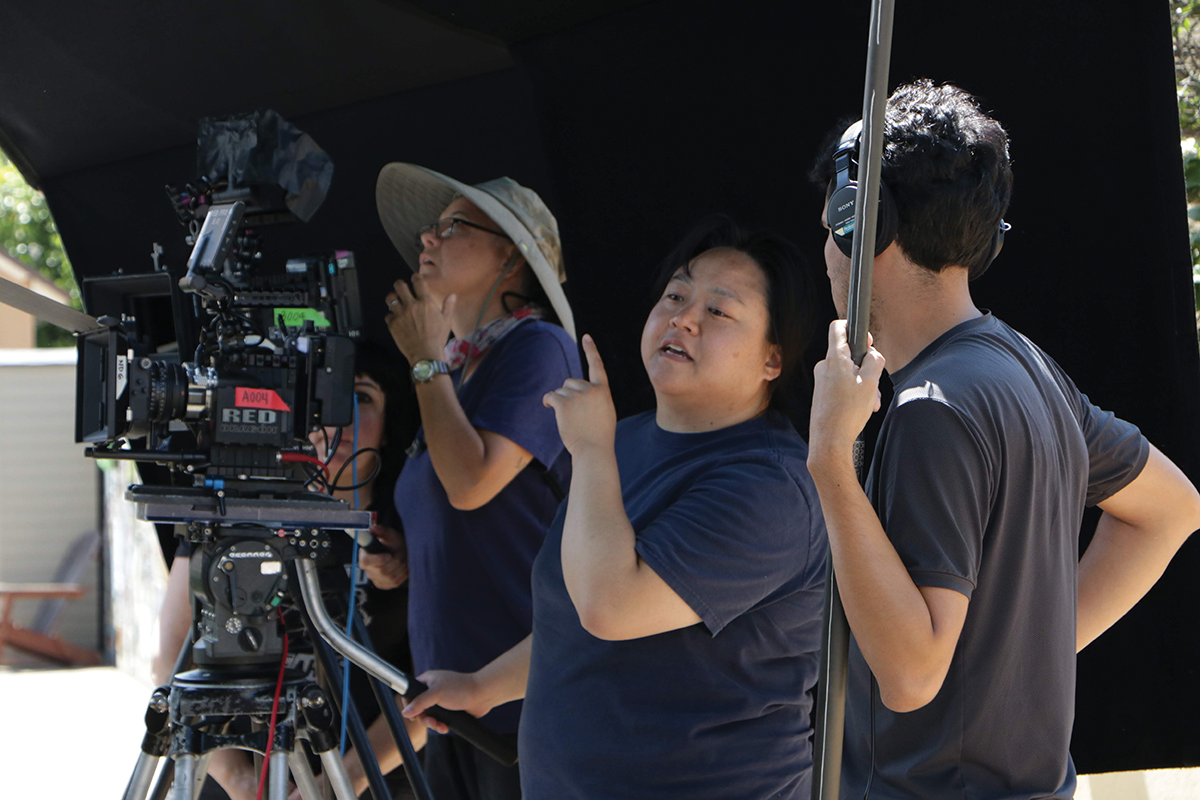
by Ernesto J. Martínez, Associate Professor, Department of Ethnic Studies
For over twelve years now, I have written on the literature and cultural production of queer people of color in the United States, examining how racially and sexually marginalized communities often rely on cultural expression to contest their subordination and to negotiate new levels of social and political intelligibility. While I am a literary scholar by training, I am also an activist and a writer who works within queer Latinx communities to create opportunities for youth empowerment and social change. “No Child Should Long For Their Own Image” is an applied research storytelling project that responds to the severe underrepresentation of queer Latinx youth in contemporary cultural production.
This project entails four components:
• the production of the queer short film La Serenata
• a discussion of the film at the University of Oregon
• a community conversation at the Eugene Public Library about queer Latinx youth and their families
• free distribution of the queer, bilingual children’s book When We Love Someone, We Sing to Them to local schools, libraries, and community centers. I am the writer for both the film and the children’s book.
La Serenata is a film adaption of a children’s book that I wrote, entitled When We Love Someone, We Sing to Them, illustrated by Maya Christina González (forthcoming, Reflections Press, 2018). The film is being directed by the Los Angeles–based Two Spirit Xicana lesbian writer and director Adelina Anthony. Both the screenplay and the children’s book tell the story of a Mexican-American boy who learns from his parents about serenatas and why demonstrating romantic affection proudly, publicly, and through song is such a treasured Mexican tradition. One day, the boy asks his parents if there is a song for a boy who loves a boy. The parents, surprised by the question and unsure of how to answer, must decide how to honor their son and how to reimagine a beloved tradition.
Both the film and the children’s book are extensions of my career as a queer Latino cultural critic. The film and the book address questions of gender identity, cultural belonging, and solidarity in age-appropriate and culturally specific ways. They challenge the association of homophobia and patriarchy with Latino families, and they guide viewers and readers to consider the healing power of music, intergenerational communication, and cultural reclamation.
Latinxs and queers are strikingly underrepresented in contemporary cultural production for youth. For example, Latinxs constitute 18 percent of the U.S. population. However, only 2.9 percent of children’s books currently reflect Latinx communities (Horning, 2017). Compare this to whites who constitute 61 percent of the U.S. population, but are over-represented in the literature written for children at 89 percent of books (Horning). The significance of this demographically skewed publishing reality is compounded by the fact that Latinx are the youngest major ethnic group in the United States, being that nearly half of all U.S.-born Latinxs are under the age of eighteen (Pew Research Center, 2016). Additionally, recent demographic analysis suggests that Latinx youth will constitute 40 percent of all youth in the United States between the year 2050 and 2060 (Sáenz, “The State of Latino Children,” 2014). These two facts—the young age of the Latinx population overall, coupled with the demographic projection that Latinx youth will constitute almost half of all youth by 2060—represents serious challenges for educators seeking to teach culturally competent material that accurately reflects the lives of the children in their classrooms.
More than simply seeking parity in representation, my goal in producing this film is to mitigate the challenges faced by queer Latinx youth in negotiating their intersectional realities. Recent studies show that self-harm runs high among minority youth, especially LGBTQ youth. As reported in the American Journal of Public Health, suicide attempts are two times higher among Black and Hispanic youth than white youth. LGBTQ youth are four times more likely than straight peers to attempt suicide. LGBTQ suicide attempts are four to six times more likely to result in injury, compared to straight peers. These statistics on suicide are alarming. Equally alarming is the reality that LGBTQ and minority youth who transgress conventional gender and racial norms become targets for deadly violence. In 2018, Anthony Avalos (a 10-year old boy) is tortured and murdered by his mother just a few days after he comes out as gay. In 2013, Gabriel Fernández (an 8-year old boy) is tortured and murdered by his father—shot with a bb gun, burned in his genitals, forced to eat cat excrement, and taunted for being gay. The same year, in 2013, an 18-year-old high school student wearing gender non-conforming clothes is set on fire while sleeping on a public bus. In 2008, Lawrence King—an eighth grader who identified as gay and wore makeup and nail polish, is shot dead by a classmate. In 2002, Gwen Araujo—a Latina transgender teen—is beat, strangled, and murdered by four men.
Our film is a cultural response to this violence. We seek to empower queer Latinx youth through stories that capture their imaginations, that represent their lives positively, and that keep them learning about their cultural roots. This project’s focus on queer Latinx youth and their families reaffirms CSWS’s longstanding commitments to the intersectional study of gender and to enhancing the social impact potential of UO faculty research.
La Serenata is being filmed in Los Angeles California, in the summer of 2018, on a three-day shoot under the direction of Adelina Anthony and in conjunction with her production company AdeRisa Productions. Since this is a film inspired by my children’s book, we have hired the illustrator of that book, Maya Christina González, to animate parts of the film. Likewise, since the film is centrally about Mexican music, we hired Grammy-nominated music composer/producer, Hector Pérez, to compose original songs and the score. AdeRisa Productions is committed to transforming the filming industry’s racism, misogyny, and patriarchy at all levels of production, and so she hires a talented team of women and people of color to meet all film production needs.
The writing process that led to the children’s book and the screenplay is grounded in anti-racist, feminist theory—specifically the work of women of color feminists who have developed modalities for understanding the decolonial potential of creative cultural production, and who have provided substantial evidence for the ability of this work to give us access and insights into various subjugated knowledges and marginalized subjectivities (Delgadillo, 2011; Soto, 2010; Blake, 2008; L. Perez, 2007; E. Perez, 1999; Moya, 1996; Hill Collins, 1990; Anzaldúa, 1987; Lorde, 1984; Walker, 1983; Moraga and Anzaldúa, 1981).
Gloria Anzaldúa is central to my thinking and writing process as a queer Latino writer. I utilize her understanding of “autohistoria-teoría” (a framework for understanding fictionalized autobiography as critical social theory), and link it with two related, process-oriented theories about art as decolonial praxis. I work with Anzaldúa’s understanding of “the path of the red and black ink” to underscore a pre-Colombian connection between escritura y sabiduria, between people who produce images (tlacuilos) and the people who interpret them (tlamatinimes), and an understanding of “writing-in-images” as a form of communication with decolonial healing and world-making potential. I also work with Anzaldúa’s psychological-spiritual notion of the “coatlicue state” to underscore how the process of writing and self-reflection often instigates, for colonized queer brown bodies, a state of deep confusion and anxiety, particularly when we come face-to-face with those forms of deep power we have been taught to fear.
—Ernesto Martínez, associate professor in the Department of Ethnic Studies, is a member of the CSWS Advisory Board. He received a 2018-19 CSWS Faculty Research Grant in support of this project. He received additional funding from an OVPRI Faculty Grant, a CLLAS Innovation Grant, and other sources. He is also a recipient of a Fund for Faculty Excellence Award for 2018-19 from the Office of the Provost and Academic Affairs.
Footnote
1. González, M.C. (2016, November 3). What I Learned from 3 Years of Teaching How to Make Children’s Books. Retrieved from http://www.mayagonzalez.com/blog/2016/11/3-years-of-teaching-how-to-make-childrens-books/
Bibliography
Acevedo, Luz Del Alba. Telling to Live: Latina Feminist Testimonios. Durham: Duke UP, 2001.
Anzaldúa, Gloria. Borderlands/La Frontera: The New Mestiza. Fourth Edition, 25th Anniversary. ed. San Francisco: Aunt Lute, 2012.
— Making Face, Making Soul/ Haciendo Caras: Creative and Critical Perspectives by Feminists of Color. First ed. San Francisco: Aunt Lute Foundation, 1990.
Bostwick, WB et. Al. “Mental Health and Suicidality Among Racially/Ethnically Diverse Sexual Minority Youths.” American Journal of Public Health. 2014 June; 104(6):1129-36.
Blake, Debra J. Chicana Sexuality and Gender: Cultural Refiguring in Literature, Oral History, and Art. Durham, NC: Duke UP, 2008.
Delgadillo, Theresa. Spiritual Mestizaje: Religion, Gender, Race, and Nation in Contemporary Chicana Narrative. Durham, NC: Duke UP, 2011.
Hames-Garcia, Michael and Martıń ez, Ernesto Javier. Gay Latino Studies: A Critical Reader. Durham, NC: Duke UP, 2011.
Hill Collins, Patricia. Black Feminist Thought: Knowledge, Consciousness, and the Politics of Empowerment. Rev. 10th Anniversary ed. New York: Routledge, 2000.
Horning, Kathleen. “Publishing Statistics on Children's Books about People of Color and First/Native Nations and by People of Color and First/Native Nations Authors and Illustrators,” University of Wisconsin, Madison. 2017.
Keating, AnaLouise. The Gloria Anzaldúa Reader. Durham, NC: Duke UP, 2009.
Lorde, Audre. Sister Outsider: Essays and Speeches. Trumansburg, NY: Crossing, 1984.
Lugones, Maria. Pilgrimages/Peregrinajes: Theorizing Coalition against Multiple Oppressions.,Lanham, Maryland: Rowman & Littlefield, 2003.
Martinez, Ernesto J. On Making Sense: Queer Race Narratives of Intelligibility. Stanford UP, 2012.
Moraga, Cherrıé ., and Anzaldúa, Gloria. This Bridge Called My Back: Writings by Radical Women of Color. 2nd ed. New York: Kitchen Table, Women of Color, 1983.
Moya, Paula. Learning from Experience: Minority Identities, Multicultural Struggles. 2002.
Patten, Eileen. “The Nation’s Latino Population Is Defined by Its Youth: Nearly Half of U.S. Born Latinos are Younger Than 18,” Pew Research Center Report, 2016.
Pérez, Emma. The Decolonial Imaginary: Writing Chicanas into History. Bloomington, IN: Indiana UP, 1999.
Pérez, Laura E. Chicana Art: The Politics of Spiritual and Aesthetic Altarities. Durham, NC: Duke UP, 2007.
Sáenz, Rogelio. “The State of Latino Children.” Report by Council on Contemporary Families, 2014.
Soto, Sandra K. Reading Chican@ like a Queer the De-mastery of Desire. 1st ed. Austin: U of Texas, 2010.
Walker, Alice. In Search of Our Mothers' Gardens: Womanist Prose. 1st ed. San Diego: Harcourt Brace Jovanovich, 1983

